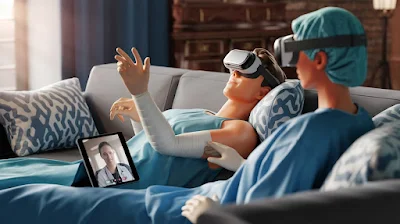Introduction :The Benefits of Remote Rehabilitation Programs
As healthcare continues to embrace digital transformation, remote rehabilitation programs have emerged as an innovative solution to help individuals recover from injuries, surgeries, or chronic conditions from the comfort of their homes. These programs leverage technology to provide patients with convenient, personalized care without the need for frequent in-person visits. In this blog, we will explore the benefits of remote rehabilitation programs, how they work, and why they are reshaping the future of physical therapy and recovery.
The Rise of Remote Rehabilitation
Rehabilitation has long been a cornerstone of recovery, whether for post-surgery patients, individuals managing chronic conditions, or those recovering from sports injuries. However, traditional rehabilitation can present logistical challenges for patients. Regular in-person visits can be time-consuming, costly, and physically difficult for individuals in need of care.
Remote rehabilitation programs, powered by advancements in telehealth technology, are changing the landscape by providing virtual rehabilitation services. Through these programs, patients can receive expert guidance from healthcare professionals, follow customized exercise plans, and track their progress—all without leaving home. The convenience and flexibility of remote rehabilitation make it an appealing option for patients, especially in today’s fast-paced world.
How Remote Rehabilitation Works
Remote rehabilitation programs utilize digital platforms to connect patients with their healthcare providers. Here's how a typical program might operate:
Initial Consultation: The process begins with an online assessment, where healthcare providers evaluate the patient’s condition and needs. This may include reviewing medical history, symptoms, and current physical abilities.
Personalized Treatment Plan: Based on the assessment, the provider creates a tailored rehabilitation program. This may include exercises, physical therapy sessions, and guidance on managing pain or discomfort.
Ongoing Monitoring: Using apps or telehealth platforms, patients can follow their treatment plan, while healthcare providers monitor progress remotely. Patients may also be required to submit regular updates, such as videos of exercises or feedback on their condition.
Real-Time Support: Throughout the process, patients can receive real-time support via virtual consultations or check-ins, ensuring they are on track with their recovery and can adjust their plan if needed.
This approach is making rehabilitation more accessible to a broader range of patients, especially those with mobility issues or busy schedules.
Advantages of Remote Rehabilitation Programs
1. Convenience and Flexibility
One of the primary benefits of remote rehabilitation is its convenience. Patients no longer need to travel to a clinic or hospital for therapy sessions. Instead, they can perform their exercises and receive guidance from the comfort of their homes. This is particularly helpful for individuals with limited mobility, busy schedules, or those who live in rural areas where accessing in-person rehabilitation services can be challenging.
2. Personalized Care
Digital rehabilitation solutions allow for highly personalized treatment plans. Using telehealth rehabilitation platforms, healthcare providers can tailor programs based on individual needs, progress, and feedback. This level of customization ensures that patients receive the care that is most effective for their recovery.
3. Cost-Effectiveness
Traditional rehabilitation often involves travel expenses, missed work, and fees for in-person visits. Remote rehabilitation programs eliminate many of these costs, making it a more affordable option for many patients. Telehealth platforms also tend to be more cost-effective for providers, as they can manage multiple patients more efficiently.
4. Improved Access to Specialists
For many patients, accessing specialized rehabilitation care can be difficult, especially if they live in underserved areas. Remote rehabilitation allows patients to connect with specialists from across the country or even globally, giving them access to expert care that might not be available locally.
5. Enhanced Patient Engagement
Online rehabilitation programs often come with tools and apps that encourage patient engagement. Patients can track their progress, set goals, and receive reminders about their exercises. This digital interaction keeps patients motivated and invested in their recovery, leading to better outcomes.
6. Continuity of Care
Remote rehabilitation ensures continuity of care, especially during times when in-person visits may not be feasible, such as during the COVID-19 pandemic. Patients can continue their rehabilitation without interruption, maintaining their progress and avoiding setbacks.
7. Data-Driven Insights
Many remote rehabilitation platforms collect data on patient progress, such as exercise performance, mobility improvements, and pain levels. Healthcare providers can use this data to make data-driven decisions, adjust treatment plans, and provide more precise care based on real-time feedback.
Real-Life Example: Telehealth for Post-Surgical Recovery
Consider the case of Sarah, a 35-year-old who recently underwent knee surgery. Post-surgery, Sarah was prescribed physical therapy to regain strength and mobility. However, with a busy work schedule and limited access to a physical therapy center, Sarah opted for a remote rehabilitation program.
Through telehealth rehabilitation, Sarah received a personalized exercise plan and weekly virtual check-ins with her therapist. The flexibility of being able to complete her therapy at home allowed her to stay consistent with her recovery while balancing her other responsibilities. Within a few months, Sarah's knee had fully recovered, and she credited the remote rehabilitation program for keeping her on track.
Potential Challenges and Considerations
While remote rehabilitation programs offer numerous benefits, there are some potential challenges to consider. For one, not all patients may have access to the technology required for virtual rehabilitation, such as smartphones, tablets, or reliable internet connections. Additionally, some patients may prefer in-person interaction with their healthcare providers, feeling that they benefit more from hands-on guidance.
Another challenge is ensuring that patients are performing their exercises correctly. While video consultations can help providers observe patients, certain conditions may require more in-depth, hands-on treatment that can only be provided in person.
The Future of Remote Rehabilitation
As technology continues to advance, the future of remote rehabilitation looks promising. Innovations in virtual reality (VR) and artificial intelligence (AI) may soon enhance these programs even further. VR platforms could provide immersive rehabilitation experiences, allowing patients to engage in interactive therapy sessions, while AI-powered tools could offer real-time feedback and adjustments to exercise plans.
With these emerging technologies, remote rehabilitation could become even more effective, offering patients an unparalleled level of support and engagement in their recovery journey.
FAQs
1. What is remote rehabilitation?
Remote rehabilitation is a type of rehabilitation program that allows patients to receive therapy and treatment remotely using digital platforms, such as telehealth apps and video consultations.
2. How do remote rehabilitation programs work?
These programs involve virtual consultations, personalized treatment plans, and ongoing monitoring from healthcare providers. Patients follow their prescribed exercises at home, while their progress is tracked remotely.
3. Who can benefit from remote rehabilitation?
Remote rehabilitation is ideal for patients recovering from surgeries, injuries, or managing chronic conditions. It is especially beneficial for those with mobility issues or individuals who live in remote or underserved areas.
4. What technology is required for remote rehabilitation?
Patients need access to a smartphone, tablet, or computer with a reliable internet connection. Many programs also use apps or telehealth platforms to guide patients through their treatment plans.
5. Is remote rehabilitation as effective as in-person therapy?
For many patients, remote rehabilitation can be just as effective as in-person therapy, particularly for those who are highly motivated and can follow their prescribed exercises. However, some conditions may still require hands-on treatment from a healthcare provider.
Conclusion
Remote rehabilitation programs offer a modern, flexible approach to recovery, allowing patients to receive personalized care from the comfort of their homes. With benefits like convenience, cost-effectiveness, and enhanced engagement, these programs are revolutionizing the way we think about rehabilitation. As technology continues to evolve, the future of remote rehabilitation promises even greater advancements, improving access and outcomes for patients around the world.








0 Comments